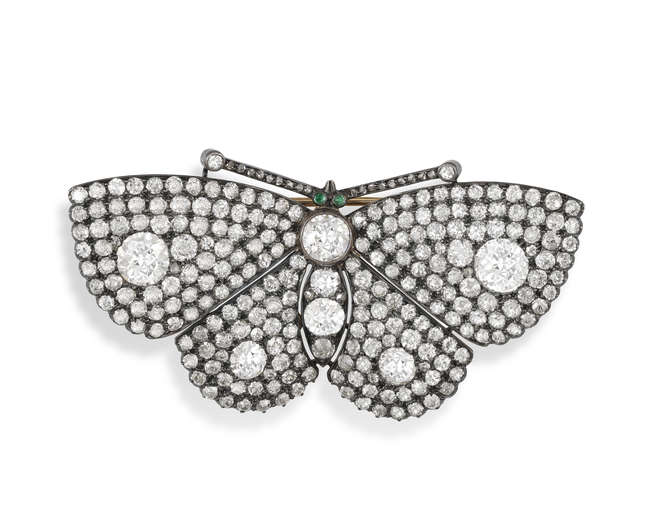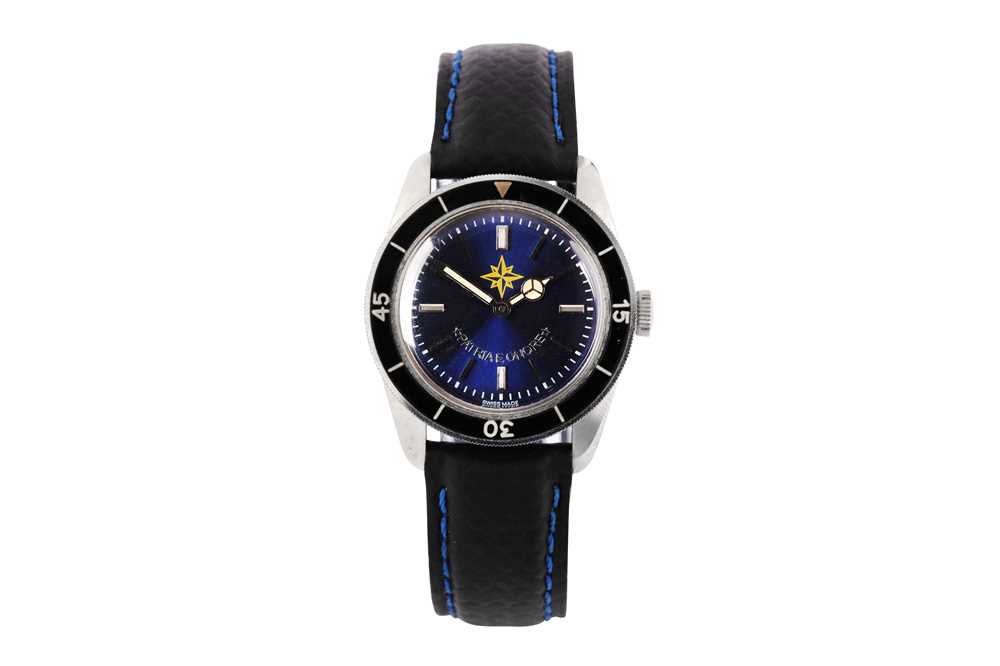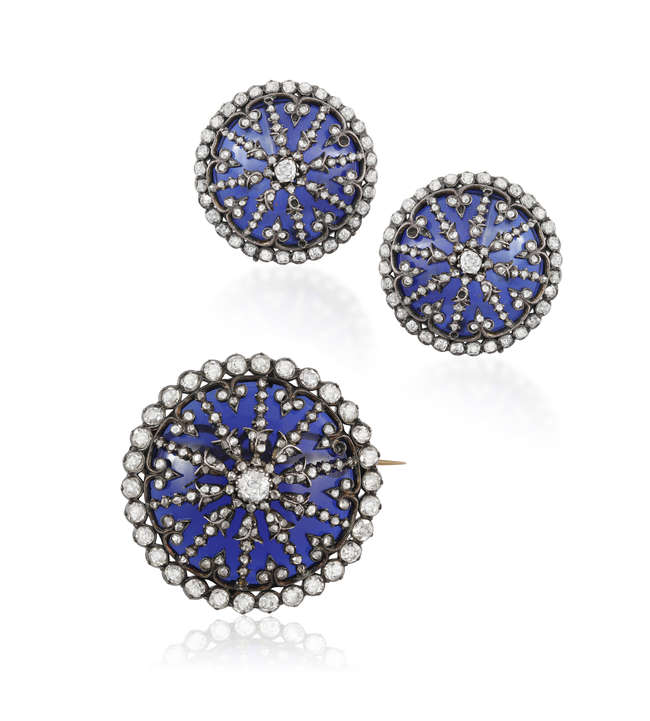THE PRIVATE COLLECTION OF A CONTINENTAL LADY (lots 83-93) A LATE 19TH CENTURY/EARLY 20TH CENTURY DIAMOND AND GEM-SET 'EN TREMBLANT' BUTTERFLY BROOCH The head, thorax and abdomen set with an old cushion-shaped diamond, a cushion-shaped diamond of yellow tint and fancy-cut emeralds accented with rose-cut diamonds, the 'en tremblant' wings pavé-set with old cushion, brilliant and single-cut diamonds, and vari-cut emeralds and rubies accented with cushion-shaped sapphires, the antennae with rose-cut diamond tips, the legs with engraved decoration, mounted in yellow gold, principal diamond approximately 0.80ct, remaining diamonds approximately 7.00cts total, cased, length 4.5cm, width 7.6cm The animal kingdom has long been a source of inspiration for jewellers. Chosen for their symbolism, their personality, or simply their beauty, a whole menagerie of creatures have been depicted in gemstones and precious metals over the ages. The butterfly is one specimen which has remained a particularly attractive subject for craftsmen. Aesthetically, the complexity of the butterfly’s form, from the meandering outline of its body to the vast array of colours found on its delicate wings, the butterfly provides the jeweller with a realm of possibilities, allowing him or her to show off their technical skill. The image of a butterfly brooch, pin or pendant perched on a lapel or resting on a neckline not only conveys a mastery of the marriage between metalwork and gemstones, but in fact conjures up a deeper meaning. A universal symbol of grace and ephemeral beauty, the butterfly has strong connotations with the human soul dating back to the Ancient Greeks. Psyche, the Greek goddess of the soul, was represented as a beautiful mortal with the wings of a butterfly. Her polychromatic wings represented the vitality of nature and symbolised the human soul as the element which connected our transient world with a more mystical one beyond it. The delicacy of the butterfly’s wings provides us with a stark reminder of the fragility of life, whilst the array of fluorescent colours is witness to the lush abundance of nature. The butterfly is the animal attribute of souls in love. During the First French Empire, when neoclassicism was in vogue, the image of the butterfly as a symbol of love became hugely popular. During the Bourbon Restoration it could be found on pendants, sometimes perched on a heart-shaped locket holding a portrait of the beloved or a lock of their hair, again a reference to the Ancient Greeks who associated the beautiful specimen as an animal attribute of Venus and Cupid. The first wife of Napoleon I, the Empress Josephine Bonaparte, singled out the butterfly as the emblem of her rule, a choice subject which strove to represent her as a loving and benevolent ruler, drawing on the butterfly as a symbol of these traits. In the 19th century, the popularity of butterfly motifs in jewellery soared to new heights as increased travel outside Europe brought with it influences from further afield. The surge in butterfly brooches and hairclips came as a result of the popularisation of Japanese art and coincided with the advent of naturalism brought about by scientific and ethnographic exploration. Western ethnographers and entomologists studying further afield, brought home detailed sketches and studies of ‘never-before-seen’ creatures residing outside the Europe. Taking inspiration from Japanese prints or the scientific drawings of an entomologist, the end of the nineteenth century saw Arts and Crafts and the Art Nouveau jewellery movements take up this intense preoccupation with depicting the natural world in a stylised manner, with an emphasis on flora and fauna. Harking back to the depiction of the Greek goddess Psyche, jewellers of this period often merged insects and female figures, depicting mesmerising metamorphic forms, such as the butterfly woman of the Maison Vever, whose ‘plique-à-jour’ diaphanous wings had no metal backing, which allowed
THE PRIVATE COLLECTION OF A CONTINENTAL LADY (lots 83-93) A LATE 19TH CENTURY/EARLY 20TH CENTURY DIAMOND AND GEM-SET 'EN TREMBLANT' BUTTERFLY BROOCH The head, thorax and abdomen set with an old cushion-shaped diamond, a cushion-shaped diamond of yellow tint and fancy-cut emeralds accented with rose-cut diamonds, the 'en tremblant' wings pavé-set with old cushion, brilliant and single-cut diamonds, and vari-cut emeralds and rubies accented with cushion-shaped sapphires, the antennae with rose-cut diamond tips, the legs with engraved decoration, mounted in yellow gold, principal diamond approximately 0.80ct, remaining diamonds approximately 7.00cts total, cased, length 4.5cm, width 7.6cm The animal kingdom has long been a source of inspiration for jewellers. Chosen for their symbolism, their personality, or simply their beauty, a whole menagerie of creatures have been depicted in gemstones and precious metals over the ages. The butterfly is one specimen which has remained a particularly attractive subject for craftsmen. Aesthetically, the complexity of the butterfly’s form, from the meandering outline of its body to the vast array of colours found on its delicate wings, the butterfly provides the jeweller with a realm of possibilities, allowing him or her to show off their technical skill. The image of a butterfly brooch, pin or pendant perched on a lapel or resting on a neckline not only conveys a mastery of the marriage between metalwork and gemstones, but in fact conjures up a deeper meaning. A universal symbol of grace and ephemeral beauty, the butterfly has strong connotations with the human soul dating back to the Ancient Greeks. Psyche, the Greek goddess of the soul, was represented as a beautiful mortal with the wings of a butterfly. Her polychromatic wings represented the vitality of nature and symbolised the human soul as the element which connected our transient world with a more mystical one beyond it. The delicacy of the butterfly’s wings provides us with a stark reminder of the fragility of life, whilst the array of fluorescent colours is witness to the lush abundance of nature. The butterfly is the animal attribute of souls in love. During the First French Empire, when neoclassicism was in vogue, the image of the butterfly as a symbol of love became hugely popular. During the Bourbon Restoration it could be found on pendants, sometimes perched on a heart-shaped locket holding a portrait of the beloved or a lock of their hair, again a reference to the Ancient Greeks who associated the beautiful specimen as an animal attribute of Venus and Cupid. The first wife of Napoleon I, the Empress Josephine Bonaparte, singled out the butterfly as the emblem of her rule, a choice subject which strove to represent her as a loving and benevolent ruler, drawing on the butterfly as a symbol of these traits. In the 19th century, the popularity of butterfly motifs in jewellery soared to new heights as increased travel outside Europe brought with it influences from further afield. The surge in butterfly brooches and hairclips came as a result of the popularisation of Japanese art and coincided with the advent of naturalism brought about by scientific and ethnographic exploration. Western ethnographers and entomologists studying further afield, brought home detailed sketches and studies of ‘never-before-seen’ creatures residing outside the Europe. Taking inspiration from Japanese prints or the scientific drawings of an entomologist, the end of the nineteenth century saw Arts and Crafts and the Art Nouveau jewellery movements take up this intense preoccupation with depicting the natural world in a stylised manner, with an emphasis on flora and fauna. Harking back to the depiction of the Greek goddess Psyche, jewellers of this period often merged insects and female figures, depicting mesmerising metamorphic forms, such as the butterfly woman of the Maison Vever, whose ‘plique-à-jour’ diaphanous wings had no metal backing, which allowed















Try LotSearch and its premium features for 7 days - without any costs!
Be notified automatically about new items in upcoming auctions.
Create an alert